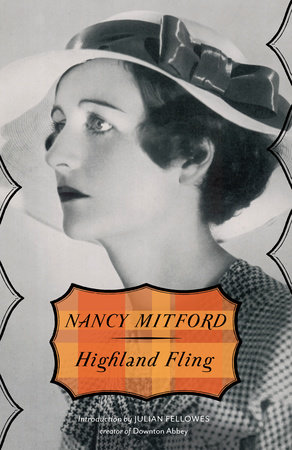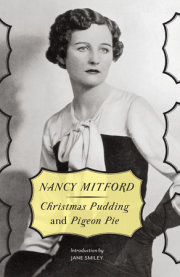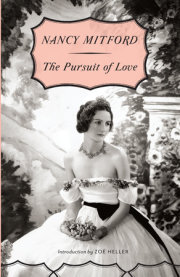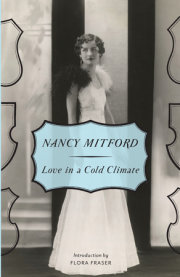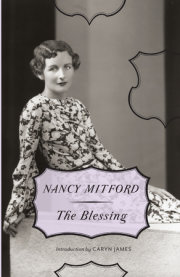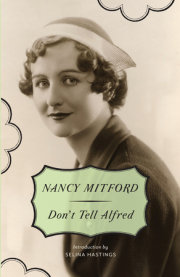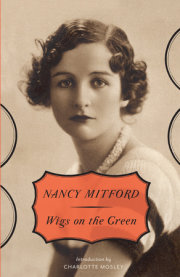In Highland Fling—Nancy Mitford’s first novel, published in 1931—a set of completely incompatible and hilariously eccentric characters collide in a Scottish castle, where bright young things play pranks on their stodgy elders until the frothy plot climaxes in ghost sightings and a dramatic fire.
Inspired in part by Mitford’s youthful infatuation with a Scottish aristocrat, her story follows young Jane Dacre to a shooting party at Dulloch Castle, where she tramps around a damp and chilly moor on a hunting expedition with formidable Lady Prague, xenophobic General Murgatroyd, one-eyed Admiral Wenceslaus, and an assortment of other ancient and gouty peers of the realm, while falling in love with Albert, a surrealist painter with a mischievous sense of humor. Lighthearted and sparkling with witty banter, Highland Fling was Mitford’s first foray into the delightful fictional world for which the author of The Pursuit of Love and Love in a Cold Climate later became so celebrated.
With an Introduction by Julian Fellowes, creator of Downton Abbey.
Inspired in part by Mitford’s youthful infatuation with a Scottish aristocrat, her story follows young Jane Dacre to a shooting party at Dulloch Castle, where she tramps around a damp and chilly moor on a hunting expedition with formidable Lady Prague, xenophobic General Murgatroyd, one-eyed Admiral Wenceslaus, and an assortment of other ancient and gouty peers of the realm, while falling in love with Albert, a surrealist painter with a mischievous sense of humor. Lighthearted and sparkling with witty banter, Highland Fling was Mitford’s first foray into the delightful fictional world for which the author of The Pursuit of Love and Love in a Cold Climate later became so celebrated.
With an Introduction by Julian Fellowes, creator of Downton Abbey.
“Highland Fling is a taster of coming delights. . . . It is the first time Mitford attempted to quantify and codify and explain the world of her beginnings, always seen with her wonderful, comic vision. . . . There is cruelty beneath the comedy, a kind of sharpness that bears testimony to the force of her judgment even when it is wrapped in the cotton wool of humour. But most of all, there is truth.” —from the Introduction by Julian Fellowes, creator of Downton Abbey
Excerpted from the Introduction
In a sense, Highland Fling is a taster of coming delights. It was Nancy Mitford’s first novel, published in 1931 when she was still in her twenties, and among its pages the reader may find seeds of the characters that would so memorably people her later books, The Pursuit of Love and Love in a Cold Climate, for both of which she is justly celebrated. General Murgatroyd is certainly the ancestor of Uncle Matthew, both descending, as they do, from Mitford’s own father, Lord Redesdale, who must surely rank as her principal source material throughout her career. I always enjoy his response when he was accused of discrimination. ‘I don’t discriminate,’ he spluttered indignantly. ‘I hate everybody.’ But alongside the splenetic General, there are clear traces of Linda Radlett in Jane Dacre, Lady Prague lays the groundwork for Lady Montdore, Albert Memorial Gates is a precursor of Cedric Hampton, and so on. But if it is fun to find the clues of what would come after, the book has its own merit in that this is the first time Mitford attempted to quantify and codify and explain the world of her beginnings, always seen with her wonderful, comic vision.
Admittedly, this world was not a hard place. Young couples live on nothing at all, highland castles are lent and borrowed, no one seems to have much in mind beyond some decent shooting and dinner at the club. Only Albert is engaged in anything remotely resembling a profession and that as a surrealist painter. Mitford’s men did not push pens or languish behind desks; her women spent their time gossiping and changing their clothes. Nor did they question the rules of a society that allowed them to idle away their days, or ask why they should be waited on hand and foot even when they hadn’t a penny to their name. But that is what makes this account of them a restful and hilarious read. It was a thoughtless age, perhaps, and even a selfish one, but without our moral smuggery which prompts every soap opera celebrity to veil their own self-obsession with much vaunted, anguished care for the environment or the survival of the whale. There is an honesty in that.
As a young woman, Nancy Mitford was madly, if quite unsuccessfully, in love with a Scottish aristocrat, Hamish St Clair-Erskine, and it is hard not to feel that Highland Fling may, in some ways, be a form of revenge after those wasted, tearful years in fruitless pursuit. How much time must she have spent in just such houses as Dalloch Castle, waiting for Hamish to love her, and how frustrating it must have been. Lord Craigdalloch himself, to say nothing of horsy Lady Brenda Chadlington or the intolerably dull Admiral Wenceslaus, all have the quality of being drawn from life, while the snobbish and philistine Lady Prague comes in for particularly savage treatment. ‘Why let her learn oils?’ said Lady Prague. ‘There are too many oil paintings in the world already. Let her do water colours. They take up much less room.’ Guided by Mitford’s sly description, we grasp at once why Lady Prague would be quite unable to resist Mrs Fairfax, an amoral bolter of the first order, because, during her many marriages, Mrs Fairfax has given birth to an English marquess and an Italian duke. ‘Dear Louisa,’ explains Lady Prague, ‘was always such a high-spirited girl, she can scarcely be blamed for her actions.’ But when others without so many connections in the ranks of the Peerage break her ladyship’s rules, there can be no mercy for them. The point is that Mitford knows these men and women. She knows how they work. She grasps their self-interest and their hypocrisy and their double standards. I would not say she never loves them, or some of them, but she knows them for what they are.
In Highland Fling, as always with this author, there is the vividness of personal experience in her work and this pre-war group do seem to embody exactly what a clever, quick-witted woman must have found so hard to endure about that oh-sopredictable life on the hill. It is a culture of watching others kill all day, getting ever more cold and wet before returning to freezing baths and bad dinners with boring people. Indeed, she writes with such relish that I am convinced the fate she metes out to the scene of their pleasures is one she wished on too many of such house parties in this unsatisfactory period of her own past. Because, for me, that is the key to Mitford’s genius: her intimate knowledge of this world and these people. Indeed, no one knew it—or certainly could articulate it—better. But, in her own way, even by this stage of her life, she had grown out of its limited values and, free as she was, she could afford to turn the torch of her own acerbic wit on a tribe who thought themselves the very acme of high life and high principle but were instead living in a foolish and largely pointless bubble, a bubble, what is more, that was soon to burst.
Of course there is cruelty here beneath the comedy, a kind of sharpness that bears testimony to the force of her judgement even where it is wrapped in the cotton wool of humour. But most of all, there is truth. And truth, as all the world knows, is the basis of great comedy.
In a sense, Highland Fling is a taster of coming delights. It was Nancy Mitford’s first novel, published in 1931 when she was still in her twenties, and among its pages the reader may find seeds of the characters that would so memorably people her later books, The Pursuit of Love and Love in a Cold Climate, for both of which she is justly celebrated. General Murgatroyd is certainly the ancestor of Uncle Matthew, both descending, as they do, from Mitford’s own father, Lord Redesdale, who must surely rank as her principal source material throughout her career. I always enjoy his response when he was accused of discrimination. ‘I don’t discriminate,’ he spluttered indignantly. ‘I hate everybody.’ But alongside the splenetic General, there are clear traces of Linda Radlett in Jane Dacre, Lady Prague lays the groundwork for Lady Montdore, Albert Memorial Gates is a precursor of Cedric Hampton, and so on. But if it is fun to find the clues of what would come after, the book has its own merit in that this is the first time Mitford attempted to quantify and codify and explain the world of her beginnings, always seen with her wonderful, comic vision.
Admittedly, this world was not a hard place. Young couples live on nothing at all, highland castles are lent and borrowed, no one seems to have much in mind beyond some decent shooting and dinner at the club. Only Albert is engaged in anything remotely resembling a profession and that as a surrealist painter. Mitford’s men did not push pens or languish behind desks; her women spent their time gossiping and changing their clothes. Nor did they question the rules of a society that allowed them to idle away their days, or ask why they should be waited on hand and foot even when they hadn’t a penny to their name. But that is what makes this account of them a restful and hilarious read. It was a thoughtless age, perhaps, and even a selfish one, but without our moral smuggery which prompts every soap opera celebrity to veil their own self-obsession with much vaunted, anguished care for the environment or the survival of the whale. There is an honesty in that.
As a young woman, Nancy Mitford was madly, if quite unsuccessfully, in love with a Scottish aristocrat, Hamish St Clair-Erskine, and it is hard not to feel that Highland Fling may, in some ways, be a form of revenge after those wasted, tearful years in fruitless pursuit. How much time must she have spent in just such houses as Dalloch Castle, waiting for Hamish to love her, and how frustrating it must have been. Lord Craigdalloch himself, to say nothing of horsy Lady Brenda Chadlington or the intolerably dull Admiral Wenceslaus, all have the quality of being drawn from life, while the snobbish and philistine Lady Prague comes in for particularly savage treatment. ‘Why let her learn oils?’ said Lady Prague. ‘There are too many oil paintings in the world already. Let her do water colours. They take up much less room.’ Guided by Mitford’s sly description, we grasp at once why Lady Prague would be quite unable to resist Mrs Fairfax, an amoral bolter of the first order, because, during her many marriages, Mrs Fairfax has given birth to an English marquess and an Italian duke. ‘Dear Louisa,’ explains Lady Prague, ‘was always such a high-spirited girl, she can scarcely be blamed for her actions.’ But when others without so many connections in the ranks of the Peerage break her ladyship’s rules, there can be no mercy for them. The point is that Mitford knows these men and women. She knows how they work. She grasps their self-interest and their hypocrisy and their double standards. I would not say she never loves them, or some of them, but she knows them for what they are.
In Highland Fling, as always with this author, there is the vividness of personal experience in her work and this pre-war group do seem to embody exactly what a clever, quick-witted woman must have found so hard to endure about that oh-sopredictable life on the hill. It is a culture of watching others kill all day, getting ever more cold and wet before returning to freezing baths and bad dinners with boring people. Indeed, she writes with such relish that I am convinced the fate she metes out to the scene of their pleasures is one she wished on too many of such house parties in this unsatisfactory period of her own past. Because, for me, that is the key to Mitford’s genius: her intimate knowledge of this world and these people. Indeed, no one knew it—or certainly could articulate it—better. But, in her own way, even by this stage of her life, she had grown out of its limited values and, free as she was, she could afford to turn the torch of her own acerbic wit on a tribe who thought themselves the very acme of high life and high principle but were instead living in a foolish and largely pointless bubble, a bubble, what is more, that was soon to burst.
Of course there is cruelty here beneath the comedy, a kind of sharpness that bears testimony to the force of her judgement even where it is wrapped in the cotton wool of humour. But most of all, there is truth. And truth, as all the world knows, is the basis of great comedy.
Copyright © 2013 by Julian Fellowes, Creator of Downton Abbey. All rights reserved. No part of this excerpt may be reproduced or reprinted without permission in writing from the publisher.
About
In Highland Fling—Nancy Mitford’s first novel, published in 1931—a set of completely incompatible and hilariously eccentric characters collide in a Scottish castle, where bright young things play pranks on their stodgy elders until the frothy plot climaxes in ghost sightings and a dramatic fire.
Inspired in part by Mitford’s youthful infatuation with a Scottish aristocrat, her story follows young Jane Dacre to a shooting party at Dulloch Castle, where she tramps around a damp and chilly moor on a hunting expedition with formidable Lady Prague, xenophobic General Murgatroyd, one-eyed Admiral Wenceslaus, and an assortment of other ancient and gouty peers of the realm, while falling in love with Albert, a surrealist painter with a mischievous sense of humor. Lighthearted and sparkling with witty banter, Highland Fling was Mitford’s first foray into the delightful fictional world for which the author of The Pursuit of Love and Love in a Cold Climate later became so celebrated.
With an Introduction by Julian Fellowes, creator of Downton Abbey.
Inspired in part by Mitford’s youthful infatuation with a Scottish aristocrat, her story follows young Jane Dacre to a shooting party at Dulloch Castle, where she tramps around a damp and chilly moor on a hunting expedition with formidable Lady Prague, xenophobic General Murgatroyd, one-eyed Admiral Wenceslaus, and an assortment of other ancient and gouty peers of the realm, while falling in love with Albert, a surrealist painter with a mischievous sense of humor. Lighthearted and sparkling with witty banter, Highland Fling was Mitford’s first foray into the delightful fictional world for which the author of The Pursuit of Love and Love in a Cold Climate later became so celebrated.
With an Introduction by Julian Fellowes, creator of Downton Abbey.
Praise
“Highland Fling is a taster of coming delights. . . . It is the first time Mitford attempted to quantify and codify and explain the world of her beginnings, always seen with her wonderful, comic vision. . . . There is cruelty beneath the comedy, a kind of sharpness that bears testimony to the force of her judgment even when it is wrapped in the cotton wool of humour. But most of all, there is truth.” —from the Introduction by Julian Fellowes, creator of Downton Abbey
Author
Excerpt
Excerpted from the Introduction
In a sense, Highland Fling is a taster of coming delights. It was Nancy Mitford’s first novel, published in 1931 when she was still in her twenties, and among its pages the reader may find seeds of the characters that would so memorably people her later books, The Pursuit of Love and Love in a Cold Climate, for both of which she is justly celebrated. General Murgatroyd is certainly the ancestor of Uncle Matthew, both descending, as they do, from Mitford’s own father, Lord Redesdale, who must surely rank as her principal source material throughout her career. I always enjoy his response when he was accused of discrimination. ‘I don’t discriminate,’ he spluttered indignantly. ‘I hate everybody.’ But alongside the splenetic General, there are clear traces of Linda Radlett in Jane Dacre, Lady Prague lays the groundwork for Lady Montdore, Albert Memorial Gates is a precursor of Cedric Hampton, and so on. But if it is fun to find the clues of what would come after, the book has its own merit in that this is the first time Mitford attempted to quantify and codify and explain the world of her beginnings, always seen with her wonderful, comic vision.
Admittedly, this world was not a hard place. Young couples live on nothing at all, highland castles are lent and borrowed, no one seems to have much in mind beyond some decent shooting and dinner at the club. Only Albert is engaged in anything remotely resembling a profession and that as a surrealist painter. Mitford’s men did not push pens or languish behind desks; her women spent their time gossiping and changing their clothes. Nor did they question the rules of a society that allowed them to idle away their days, or ask why they should be waited on hand and foot even when they hadn’t a penny to their name. But that is what makes this account of them a restful and hilarious read. It was a thoughtless age, perhaps, and even a selfish one, but without our moral smuggery which prompts every soap opera celebrity to veil their own self-obsession with much vaunted, anguished care for the environment or the survival of the whale. There is an honesty in that.
As a young woman, Nancy Mitford was madly, if quite unsuccessfully, in love with a Scottish aristocrat, Hamish St Clair-Erskine, and it is hard not to feel that Highland Fling may, in some ways, be a form of revenge after those wasted, tearful years in fruitless pursuit. How much time must she have spent in just such houses as Dalloch Castle, waiting for Hamish to love her, and how frustrating it must have been. Lord Craigdalloch himself, to say nothing of horsy Lady Brenda Chadlington or the intolerably dull Admiral Wenceslaus, all have the quality of being drawn from life, while the snobbish and philistine Lady Prague comes in for particularly savage treatment. ‘Why let her learn oils?’ said Lady Prague. ‘There are too many oil paintings in the world already. Let her do water colours. They take up much less room.’ Guided by Mitford’s sly description, we grasp at once why Lady Prague would be quite unable to resist Mrs Fairfax, an amoral bolter of the first order, because, during her many marriages, Mrs Fairfax has given birth to an English marquess and an Italian duke. ‘Dear Louisa,’ explains Lady Prague, ‘was always such a high-spirited girl, she can scarcely be blamed for her actions.’ But when others without so many connections in the ranks of the Peerage break her ladyship’s rules, there can be no mercy for them. The point is that Mitford knows these men and women. She knows how they work. She grasps their self-interest and their hypocrisy and their double standards. I would not say she never loves them, or some of them, but she knows them for what they are.
In Highland Fling, as always with this author, there is the vividness of personal experience in her work and this pre-war group do seem to embody exactly what a clever, quick-witted woman must have found so hard to endure about that oh-sopredictable life on the hill. It is a culture of watching others kill all day, getting ever more cold and wet before returning to freezing baths and bad dinners with boring people. Indeed, she writes with such relish that I am convinced the fate she metes out to the scene of their pleasures is one she wished on too many of such house parties in this unsatisfactory period of her own past. Because, for me, that is the key to Mitford’s genius: her intimate knowledge of this world and these people. Indeed, no one knew it—or certainly could articulate it—better. But, in her own way, even by this stage of her life, she had grown out of its limited values and, free as she was, she could afford to turn the torch of her own acerbic wit on a tribe who thought themselves the very acme of high life and high principle but were instead living in a foolish and largely pointless bubble, a bubble, what is more, that was soon to burst.
Of course there is cruelty here beneath the comedy, a kind of sharpness that bears testimony to the force of her judgement even where it is wrapped in the cotton wool of humour. But most of all, there is truth. And truth, as all the world knows, is the basis of great comedy.
In a sense, Highland Fling is a taster of coming delights. It was Nancy Mitford’s first novel, published in 1931 when she was still in her twenties, and among its pages the reader may find seeds of the characters that would so memorably people her later books, The Pursuit of Love and Love in a Cold Climate, for both of which she is justly celebrated. General Murgatroyd is certainly the ancestor of Uncle Matthew, both descending, as they do, from Mitford’s own father, Lord Redesdale, who must surely rank as her principal source material throughout her career. I always enjoy his response when he was accused of discrimination. ‘I don’t discriminate,’ he spluttered indignantly. ‘I hate everybody.’ But alongside the splenetic General, there are clear traces of Linda Radlett in Jane Dacre, Lady Prague lays the groundwork for Lady Montdore, Albert Memorial Gates is a precursor of Cedric Hampton, and so on. But if it is fun to find the clues of what would come after, the book has its own merit in that this is the first time Mitford attempted to quantify and codify and explain the world of her beginnings, always seen with her wonderful, comic vision.
Admittedly, this world was not a hard place. Young couples live on nothing at all, highland castles are lent and borrowed, no one seems to have much in mind beyond some decent shooting and dinner at the club. Only Albert is engaged in anything remotely resembling a profession and that as a surrealist painter. Mitford’s men did not push pens or languish behind desks; her women spent their time gossiping and changing their clothes. Nor did they question the rules of a society that allowed them to idle away their days, or ask why they should be waited on hand and foot even when they hadn’t a penny to their name. But that is what makes this account of them a restful and hilarious read. It was a thoughtless age, perhaps, and even a selfish one, but without our moral smuggery which prompts every soap opera celebrity to veil their own self-obsession with much vaunted, anguished care for the environment or the survival of the whale. There is an honesty in that.
As a young woman, Nancy Mitford was madly, if quite unsuccessfully, in love with a Scottish aristocrat, Hamish St Clair-Erskine, and it is hard not to feel that Highland Fling may, in some ways, be a form of revenge after those wasted, tearful years in fruitless pursuit. How much time must she have spent in just such houses as Dalloch Castle, waiting for Hamish to love her, and how frustrating it must have been. Lord Craigdalloch himself, to say nothing of horsy Lady Brenda Chadlington or the intolerably dull Admiral Wenceslaus, all have the quality of being drawn from life, while the snobbish and philistine Lady Prague comes in for particularly savage treatment. ‘Why let her learn oils?’ said Lady Prague. ‘There are too many oil paintings in the world already. Let her do water colours. They take up much less room.’ Guided by Mitford’s sly description, we grasp at once why Lady Prague would be quite unable to resist Mrs Fairfax, an amoral bolter of the first order, because, during her many marriages, Mrs Fairfax has given birth to an English marquess and an Italian duke. ‘Dear Louisa,’ explains Lady Prague, ‘was always such a high-spirited girl, she can scarcely be blamed for her actions.’ But when others without so many connections in the ranks of the Peerage break her ladyship’s rules, there can be no mercy for them. The point is that Mitford knows these men and women. She knows how they work. She grasps their self-interest and their hypocrisy and their double standards. I would not say she never loves them, or some of them, but she knows them for what they are.
In Highland Fling, as always with this author, there is the vividness of personal experience in her work and this pre-war group do seem to embody exactly what a clever, quick-witted woman must have found so hard to endure about that oh-sopredictable life on the hill. It is a culture of watching others kill all day, getting ever more cold and wet before returning to freezing baths and bad dinners with boring people. Indeed, she writes with such relish that I am convinced the fate she metes out to the scene of their pleasures is one she wished on too many of such house parties in this unsatisfactory period of her own past. Because, for me, that is the key to Mitford’s genius: her intimate knowledge of this world and these people. Indeed, no one knew it—or certainly could articulate it—better. But, in her own way, even by this stage of her life, she had grown out of its limited values and, free as she was, she could afford to turn the torch of her own acerbic wit on a tribe who thought themselves the very acme of high life and high principle but were instead living in a foolish and largely pointless bubble, a bubble, what is more, that was soon to burst.
Of course there is cruelty here beneath the comedy, a kind of sharpness that bears testimony to the force of her judgement even where it is wrapped in the cotton wool of humour. But most of all, there is truth. And truth, as all the world knows, is the basis of great comedy.
Copyright © 2013 by Julian Fellowes, Creator of Downton Abbey. All rights reserved. No part of this excerpt may be reproduced or reprinted without permission in writing from the publisher.
Back to Top
Notifications






